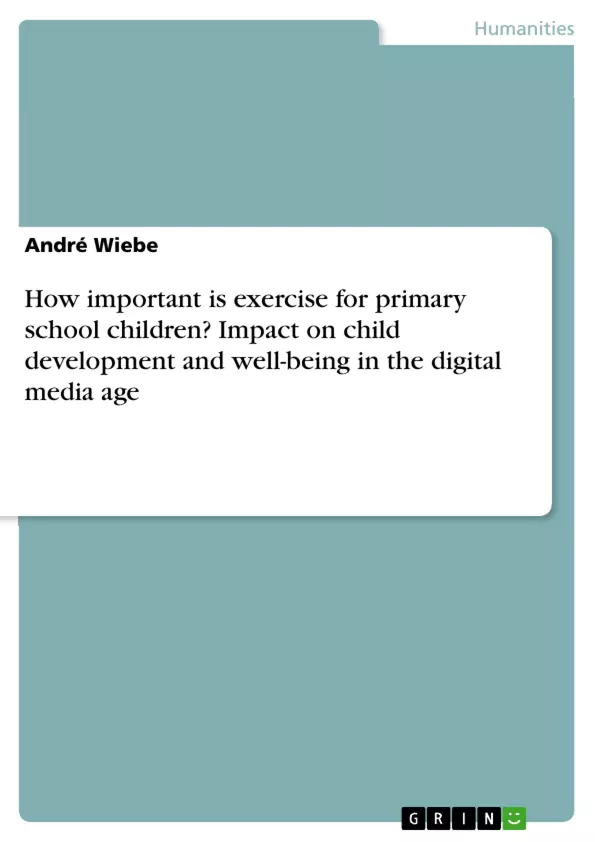Primary school children in Germany are increasingly suffering from poor posture, overweight and cardiovascular weaknesses. This is primarily due to a lack of exercise. According to the WHO, children and young people should be physically active for at least 60 minutes a day - a value that has long since been missed in the digital age.
André Wiebe reveals what the movement behavior of children looks like at the moment. Between 2009 and 2012, just 31 percent of German elementary school children achieved the recommended minimum level of physical activity. But why is this value so low?
Wiebe examines the different areas of children's lives and evaluates current studies. It illustrates the change that has occurred in recent years and whether the downward trend is necessarily negative. His publication is an important guide for social work with elementary school children.
From the content:
- Sedentary lifestyle;
- Digital media;
- Smartphone;
- Social networks;
- Obesity;
- KiGGS study
Inhaltsverzeichnis (Table of Contents)
- 1 Introduction
- 2 Movement in development
- 2.1 Movement as a basic child's need
- 2.2 Effect on cognitive abilities
- 2.3 Effect on physical condition
- 2.4 Movement and social development
- 3 The influence of movement on the development of the self
- 3.1 The influence of movement on the self-concept
- 3.2 The Influence of Exercise on Self-Efficacy
- 3.3 Negative development of the self due to lack of exercise
- 4 KiGGS study
- 4.1 General information
- 4.2 Relevant results for the present work
- 5 Movement of primary school children today and possibilities for further shaping movement
- 5.1 Movement spaces
- 5.2 Digital media as a contributor to a lack of exercise
- 6 Well-being
- 6.1 Subjective and objective well-being
- 6.2 Physical activity and state of health
- 6.3 Physical activity and balance
- 7 Final reflection
- 7.1 Summary and conclusions
- 7.2 Appeal to social work
Zielsetzung und Themenschwerpunkte (Objectives and Key Themes)
This work examines the importance of exercise for primary school children in the digital media age, focusing on its impact on child development and well-being. It aims to understand how physical activity contributes to cognitive, physical, social, and self-development in children. Additionally, it explores the influence of digital media on movement behavior and its potential negative effects on children's well-being.
- The importance of physical activity in child development
- The impact of exercise on cognitive, physical, and social development
- The role of digital media in shaping children's movement behavior
- The potential negative consequences of reduced physical activity on children's well-being
- The need for strategies to promote physical activity and combat the negative influences of digital media
Zusammenfassung der Kapitel (Chapter Summaries)
The first chapter provides an introduction to the topic of movement and its importance in human life, particularly during childhood. It highlights the growing concern about children's decreasing levels of physical activity and its implications for their health and well-being. This introduction sets the stage for the subsequent chapters, which delve deeper into the various aspects of exercise and its impact on children's development.
Chapter 2 explores the fundamental role of movement in child development. It discusses how exercise contributes to the development of cognitive abilities, physical fitness, and social skills. This chapter highlights the importance of physical activity as a crucial factor in a child's overall growth and development.
Chapter 3 examines the intricate relationship between movement and the development of a child's self-concept and self-efficacy. It analyzes how physical activity positively influences these aspects of the child's self-image and how a lack of exercise can have negative repercussions. This chapter underscores the importance of physical activity in fostering a healthy self-image and a sense of competence in children.
Chapter 4 presents the findings of the KiGGS study, a large-scale research project examining the health of German children and adolescents. This chapter focuses on the study's relevant results concerning the movement behavior of primary school children and the potential implications for their well-being. This chapter provides empirical data to support the arguments presented in previous chapters.
Chapter 5 delves into the current movement behavior of primary school children and explores the challenges they face in maintaining an active lifestyle. This chapter examines the limitations of movement spaces and the increasing role of digital media in contributing to sedentary behavior among children. It also discusses strategies for promoting physical activity and combating the negative influence of digital media.
Chapter 6 investigates the concept of well-being and its relationship to physical activity. It examines how physical activity contributes to both subjective and objective well-being, and how it can positively impact a child's overall state of health and balance. This chapter concludes by stressing the importance of promoting physical activity for the sake of children's overall well-being.
Schlüsselwörter (Keywords)
The main keywords of this work are: exercise, physical activity, child development, well-being, digital media, primary school children, movement behavior, cognitive abilities, physical condition, social development, self-concept, self-efficacy, KiGGS study, movement spaces, sedentary behavior, health, balance.
- Quote paper
- André Wiebe (Author), 2018, How important is exercise for primary school children? Impact on child development and well-being in the digital media age, Munich, GRIN Verlag, https://www.grin.com/document/1187829



